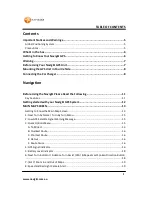
5
Scenarios and examples
For this chapter It is assumed that the reader already has access to the
unit’s TAIP console trough the unit’s serial port using a terminal software
like Windows
TM
’ Hyperterminal
TM
. Refer to the
Operation
chapter for more
information.
5.1
Getting Started
This example is a step by step instructional on getting started with the unit.
At the end the reader should have the unit reporting an input activation
and a periodic message to an IP host.
5.1.1
Setting the unit’s ID
In order for the unit to be identified on an AVL server an ID has to be set.
The default value for the unit’s ID is
0000
. This field may be any string of
10 characters maximum.
For this example lets call our unit
EXAMPLE
:
>
SIDEXAMPLE
<
5.1.2
Setting the APN and PIN
After configuring an ID, the first step is enabling the unit on the GSM/GPRS
network. For this an APN provided by the cellular carrier is required and de-
pending on the SIM card configuration a PIN value will be required too. For
this example we will use APN
internet.carrier-name.com
and PIN
1234
.
Setting the SIM card’s PIN:
>
SRFI1234
<
If your SIM card does not requires a PIN you can omit this step.
Setting the APN:
>
SRFAinternet.carrier-name.com
<
At this point the until will try to register on GSM and on GPRS.
Although PIN and APN parameters take effect immediately the
unit may take up some time on registering to the network if a
previous erroneous PIN was used. You can wait for the unit to
register or you can speed up the process by resetting it with the
>
SRT
<
command.
Note:
Summary of Contents for Antares SB
Page 1: ......
Page 2: ...Antares SB TM GSM User s Manual FW 5 21 Digital Communications Technologies April 15 2008...
Page 37: ...2 1 POWER SUPPLY 35...
Page 38: ...2 1 POWER SUPPLY 36...
Page 42: ...2 5 CONNECTION DIAGRAMS 40...
Page 141: ...6 Unit s TAIP reference...
Page 191: ...6 32 XADM DIAGNOSTIC MESSAGE 189...
Page 228: ......
Page 229: ......
















































